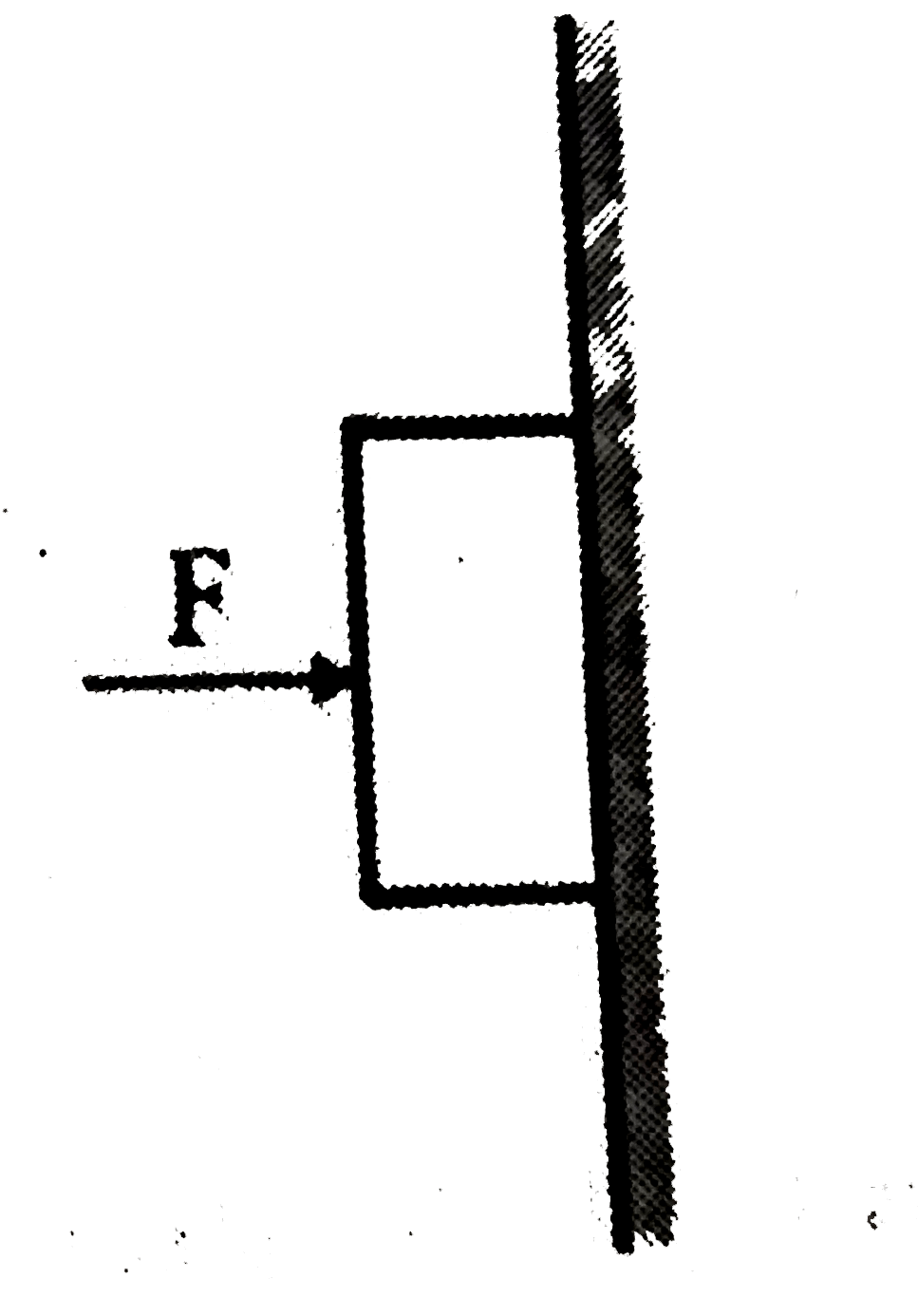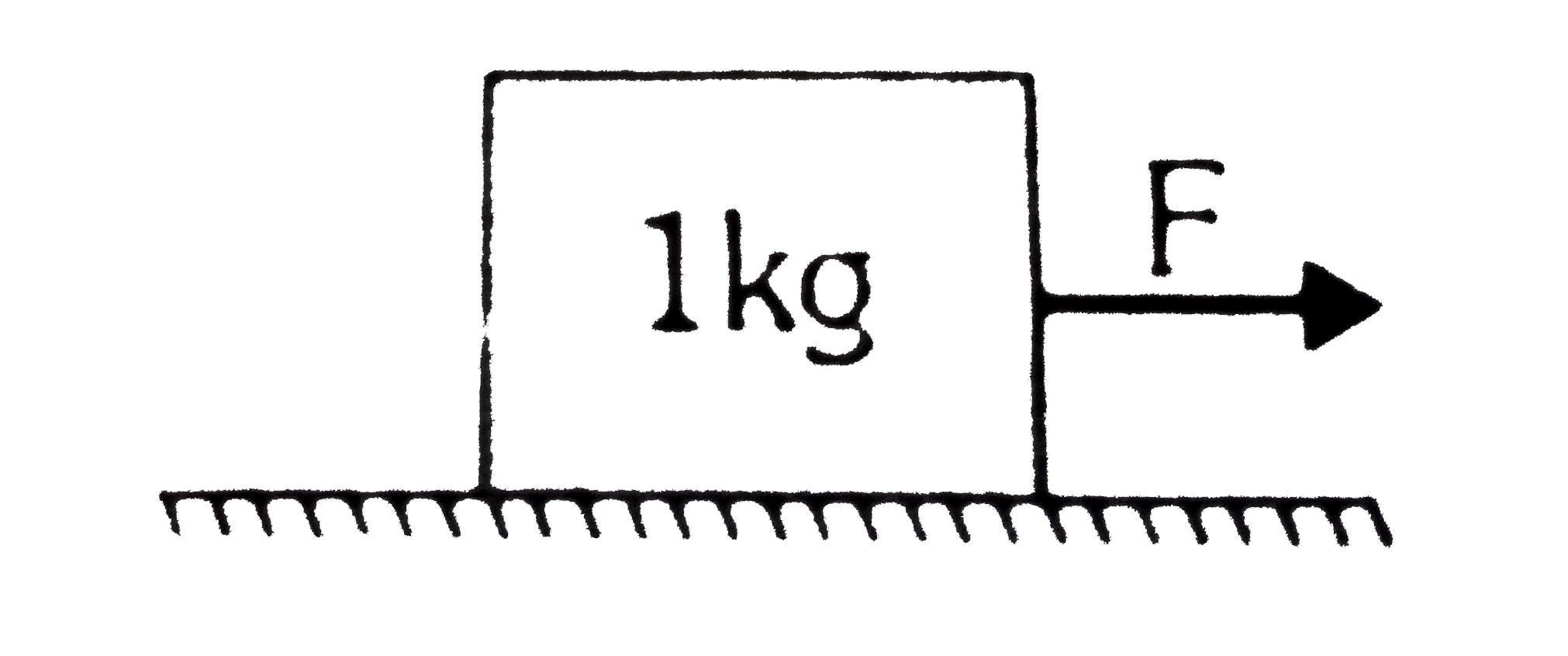A block of mass 2kg si kept at rest at x=0, on a rough horizontal surface with coefficient of a rough horizontal surface with coefficient of friction 0.2. A position dependent horizontal force given by F=x2+2x+5 (where x is in meter and F is in Newton), starts acting on the block at x=0. The kenetic energy of block at x=3 is :
21J
33J
45J
12J
The correct Answer is:A
To find the kinetic energy of the block at x=3, we will follow these steps:
Step 1: Determine the Forces Acting on the Block
The block experiences a position-dependent force given by:
F(x)=x2+2x+5
The normal force N acting on the block is equal to its weight since it is on a horizontal surface:
N=mg=2kg×9.8m/s2=19.6N
The limiting frictional force flim can be calculated using the coefficient of friction μ=0.2:
flim=μN=0.2×19.6N=3.92N
Step 2: Analyze the Force at x=3
We need to check if the applied force F(x) exceeds the limiting friction. Let's calculate F(3):
F(3)=32+2⋅3+5=9+6+5=20N
Since 20N>3.92N, the block will move, and the frictional force will act in the opposite direction to the applied force.
Step 3: Calculate the Net Force
The net force Fnet acting on the block can be calculated as:
Fnet=F(x)−flim=20N−3.92N=16.08N
Step 4: Relate Force to Acceleration
Using Newton's second law, we can relate the net force to the acceleration a:
Fnet=ma⟹a=Fnetm=16.08N2kg=8.04m/s2
Step 5: Use Work-Energy Principle
The work done on the block will equal the change in kinetic energy. The work done W can be calculated as:
W=Fnet⋅d=16.08N⋅3m=48.24J
Since the block starts from rest, the initial kinetic energy KEi=0. Thus, the final kinetic energy KEf at x=3 is:
KEf=KEi+W=0+48.24J=48.24J
Final Answer
The kinetic energy of the block at x=3 is:
48.24J
The block experiences a position-dependent force given by:
F(x)=x2+2x+5
The normal force N acting on the block is equal to its weight since it is on a horizontal surface:
N=mg=2kg×9.8m/s2=19.6N
The limiting frictional force flim can be calculated using the coefficient of friction μ=0.2:
flim=μN=0.2×19.6N=3.92N
We need to check if the applied force F(x) exceeds the limiting friction. Let's calculate F(3):
F(3)=32+2⋅3+5=9+6+5=20N
Since 20N>3.92N, the block will move, and the frictional force will act in the opposite direction to the applied force.
The net force Fnet acting on the block can be calculated as:
Fnet=F(x)−flim=20N−3.92N=16.08N
Using Newton's second law, we can relate the net force to the acceleration a:
Fnet=ma⟹a=Fnetm=16.08N2kg=8.04m/s2
The work done on the block will equal the change in kinetic energy. The work done W can be calculated as:
W=Fnet⋅d=16.08N⋅3m=48.24J
Since the block starts from rest, the initial kinetic energy KEi=0. Thus, the final kinetic energy KEf at x=3 is:
KEf=KEi+W=0+48.24J=48.24J
The kinetic energy of the block at x=3 is:
48.24J
Topper's Solved these Questions
- TEST PAPERSBook:RESONANCE ENGLISHChapter:TEST PAPERSExercise:PART - II PHYSICS
Explore 106 Videos
- SIMPLE HARMONIC MOTION Book:RESONANCE ENGLISHChapter:SIMPLE HARMONIC MOTION Exercise:Advanced Level Problems
Explore 13 Videos
- TEST SERIESBook:RESONANCE ENGLISHChapter:TEST SERIESExercise:PHYSICS
Explore 130 Videos
Similar Questions
A block of mass 1 kg is held at rest against a rough vertical surface by pushing by a force F horizontally. The coefficient of friction is 0.5. When

View SolutionA force of 49 N just able to move a block of wood weighing 10 kg on a rough horizontal surface , then coefficient of friction is
View Solution
Knowledge Check
A block of mass 10kg is placed on a rough horizontal surface having coefficient of friction μ=0.5 . If a horizontal force of 100N is acting on it, then acceleration of the block will be.
A10ms−2B5ms−2C15ms−2D0.5ms−2
A block of mass 10kg is placed on a rough horizontal surface having coefficient of friction μ=0.5 . If a horizontal force of 100N is acting on it, then acceleration of the will be.
View SolutionA block of mass 10kg is placed on a rough horizontal surface having coefficient of friction μ=0.5 . If a horizontal force of 100N is acting on it, then acceleration of the will be.
View SolutionA force of 10N is acting on a block of 20kg on horizontal surface with coefficient of friction μ=0.2. Calculate the work done by the force.
View SolutionA block is sliding on a rough horizontal surface. If the contact force on the block is √2 times the frictional force, the coefficient of friction is
View SolutionA block of mass 1kg is at rest on a rough horizontal surface having coefficient of static friction 0.2 and kinetic friciton 0.15, find the frictional forces if a horizontal force,
(a) F=1N (b) F=1.96N (c) F=2.5N is applied on a block

View SolutionA block of mass 10kg is placed on a rough horizontal surface having coefficient of friction μ=0.5 . If a horizontal force of 100N is acting on it, then acceleration of the block will be.
View SolutionA block of mass 20kg is placed on a rough horizontal plane and a horizontal force of 12N is applied. If coefficient of friction is 0.1 the frictional force acting on it is,
View Solution

